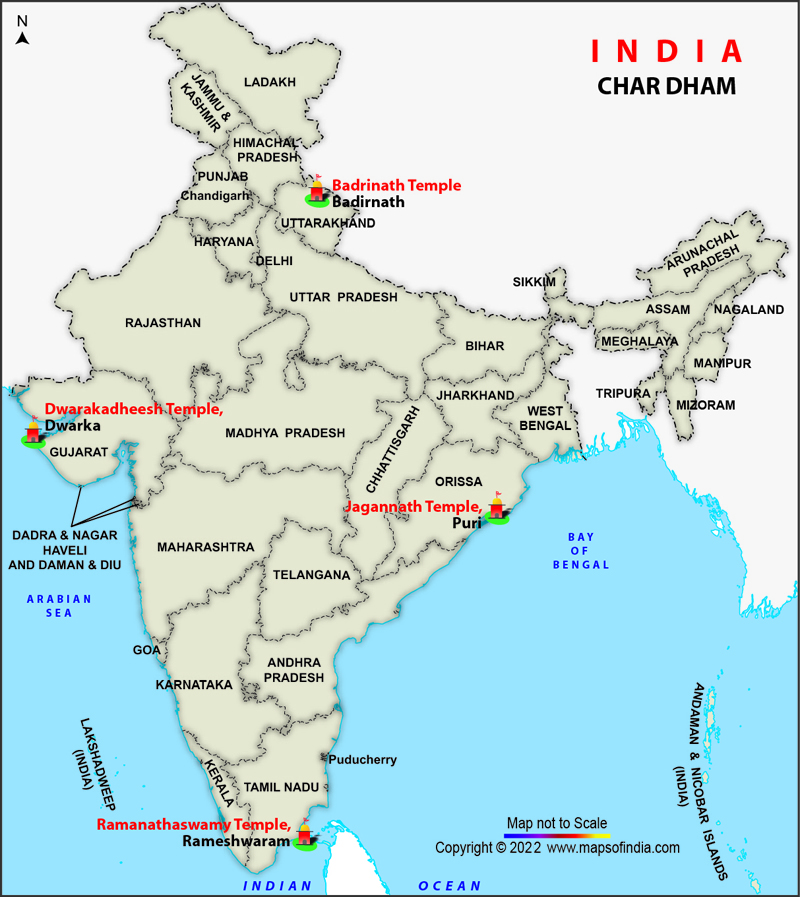Char Dham form a square as Badrinath and Rameswaram fall on the same longitude and Dwarka and Puri fall on the same latitude. The four abodes have their own significance and importance in Hindu mythology.
Badrinath
The Badrinath Dham is one of the sacred places located in the Himalayas. It is situated in the Badrinath town in Uttarakhand at a height of 3133m above sea level. The Badrinath Temple is dedicated to Lord Vishnu and it is believed that he had done his penance at this holy place. According to the mythological beliefs, when Goddess Mahalaxmi saw Lord Vishnu undertaking his penance in open, she took the form of Badari tree and provided him shelter to protect him from adverse weather conditions. Hence, the temple is named as Badari Narayan. The Kings of Garhwal have built the present structure of the temple. The Lord Badari Narayan carries a Shankh (Conch) in one hand and Chakra in the other. The other two arms rest on the lap in Yogamudra. The best time to visit this pilgrimage site is from May to October except monsoons.
Puri
The Jagannath Temple is located in Puri, Odisha. The name 'Jagannath' is derived from the word 'Jagat Nath', which means the 'Lord of the Universe'. The deities of Jagannath, Balabhadra and Subhadra are worshipped in the temple. The idols of these deities are made from wood. After every twelve years, these wooden idols are replaced ceremoniously with the wood of sacred trees. Exactly same replica of the wooden statues is prepared during every ceremony. Daily worship in the temple takes place four times a day- 1, 5, 9 and 11 am. An annual Rath Yatra or the Chariot Festival is held in Puri for Lord Jagannath. During this yatra, the three deities are taken out on a procession and kept for nine days at Gundicha Temple. The best time to visit Puri is from October to April.
Rameswaram
Ramanathaswamy Temple, located in the island of Rameswaram is dedicated to Lord Shiva. It gained this name because here Lord Rama worshipped Lord Shiva, when he returned from Sri Lanka. It is believed that after Rama killed Ravana, in order to clear the "dosha" of killing a brahim, he worshipped an idol of Lord Shiva here which was brought by Lord Hanuman from Kailash. The deity of Shiva, in the temple, is in the form of lingam. There are two lingams in this holy place, one that Goddess Sita had built with sand and the other one which Lord Hanuman brought from Kailash. For the devotees, the temple is open from 5 am to 9 pm (except 1-3 p.m.). The main poojas are performed six times a day. The time from October to April is the best to visit this pilgrimage site.
Dwarka
Dwarkadhish Temple, popularly known as Jagat mandir is located in Dwarka, Gujarat. It is dedicated to Lord Krishna who is also known as the 'King of Dwarka'. As per Hindu mythology the temple was built by Vajranabha, grandson of Lord Krishna at hari-griha, the resident place of Lord Krishna. The temple is also known as Mokshapuri as it is believed that a person can achieve moksha if he visits this temple. The festival of Janamashtmi, also known as Krishna Janmotsav, is very popular among the devotees here. The timings for darshan in the temple everyday is from 6.30 am to 1 pm and then from 5 pm to 9 pm. The best months to visit the temple are from October to March.
The Char Dhams are run and maintained by their respective committees and the government also takes adequate measures to provide services to the devotees and for the maintenance of the temples. All these pilgrimages are well connected through rail, road and air. Every year thousands of devotees visit these places and worship their idols.
WBST121214
EBAKB070115
Last Updated on : November 13, 2025
India general Maps
